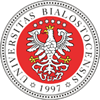Proszę używać tego identyfikatora do cytowań lub wstaw link do tej pozycji:
http://hdl.handle.net/11320/17843Pełny rekord metadanych
| Pole DC | Wartość | Język |
|---|---|---|
| dc.contributor.author | Wołoszyn, Adam | - |
| dc.date.accessioned | 2025-01-15T10:47:11Z | - |
| dc.date.available | 2025-01-15T10:47:11Z | - |
| dc.date.issued | 2024 | - |
| dc.identifier.citation | Miscellanea Historico-Iuridica, T. 23, Z. 1, 2024, s. 91-113 | pl |
| dc.identifier.issn | 1732-9132 | - |
| dc.identifier.uri | http://hdl.handle.net/11320/17843 | - |
| dc.description.abstract | Artykuł prezentuje rodzaje kar stosowanych w armii szwedzkiej na przełomie XVII i XVIII wieku na podstawie Artykułów Wojskowych Karola XI Wittelsbach (1660–1697) ustanowionych 2 marca 1683 roku w Sztokholmie, które składały się z 145 przepisów podzielonych na 25 rozdziałów a także: pięciu instrukcji i tylu edyktów królewskich oraz sześciu modlitw. Przedstawione zostały w nim przyczyny wprowadzenia nowej kodyfikacji wojskowej, które wynikały z kryzysu wojskowości szwedzkiej po zakończeniu II wojny północnej (1655–1660), a następnie scharakteryzowano jej części składowe oraz zaznaczono silne powiązanie ze sferą religijną (protestantyzm). Wymienione w analizowanym źródle kary opisano. Były to kary na ciele: kara śmierci (powieszenie, decymacja, ścięcie mieczem, rozstrzelanie, spalenie na stosie), chłosta (w tym bieg przez rózgi), areszt, więzienie, kajdany, głodówka, okaleczenie (mutylacja), noszenie ciężaru; kary na honorze: utrata praw honorowych, publiczna pokuta, przeprosiny, zesłanie poza obóz, zawieszenie, degradacja, wydalenie ze służby; czy kary finansowe: grzywna, utrata żołdu lub konfiskata majątku. Przy każdej wskazano, za jakie przestępstwa była stosowana, przy czym wyjaśniono, dlaczego zasądzano różne kary za to samo przewinienie. W podsumowaniu natomiast zwrócono uwagę, że Artykuły Wojskowe Karola XI były bardzo rygorystyczne, co przekładało się na wysoką dyscyplinę oddziałów szwedzkich podczas walk w czasie Wielkiej Wojny Północnej (1700–1721). Stanowiły one również inspirację dla innych kodyfikacji wojskowych, w tym rosyjskiego kodeksu wojskowego Piotra I Wielkiego z 1716 roku. | pl |
| dc.description.abstract | The article presents the types of punishment used in the Swedish army at the turn of the 17th and 18th centuries on the basis of the Military Articles of Charles XI Wittelsbach (1660–1697) established on 2 March 1683 in Stockholm, which consisted of 145 rules divided into 25 chapters as well as: five instructions and as many royal edicts and six prayers. It outlines the reasons for the new military codification, which stemmed from the crisis in the Swedish military after the end of the Second Northern War (1655–1660), then characterises its constituent parts and notes its strong connection to the religious sphere (Protestantism). The punishments mentioned in the analysed source were described. These were punishments on the body: capital punishment (hanging, decimation, beheading with a sword, execution, burning at the stake), flogging (including running through the rods), arrest, imprisonment, shackles, starvation, mutilation, carrying a burden; punishments on honour: loss of the public rights of honour, public penance, apology, exile outside the camp, suspension, demotion, expulsion from service; or financial penalties: fine, loss of pay or confiscation of property. For each, it is indicated for which offences it was applied, with an explanation of why different punishments were awarded for the same offence. In contrast, the conclusion notes that Charles XI’s Military Articles were very strict, which translated into high discipline of Swedish troops during the fighting of the Great Northern War (1700–1721). They also provided inspiration for other military codifications, including the Russian Military Code of Peter the Great in 1716. | pl |
| dc.language.iso | pl | pl |
| dc.publisher | Wydawnictwo Uniwersytetu w Białymstoku | pl |
| dc.rights | Uznanie autorstwa-Na tych samych warunkach 4.0 Międzynarodowe (CC BY-SA 4.0) | - |
| dc.rights.uri | https://creativecommons.org/licenses/by-sa/4.0/deed.pl | - |
| dc.subject | Karol XI Wittelsbach | pl |
| dc.subject | armia szwedzka | pl |
| dc.subject | Artykuły Wojskowe 1683 (Szwecja) | pl |
| dc.subject | prawo wojskowe | pl |
| dc.subject | kary | pl |
| dc.subject | Charles XI Wittelsbach | pl |
| dc.subject | Swedish army | pl |
| dc.subject | Military Articles 1683 (Sweden) | pl |
| dc.subject | military law | pl |
| dc.subject | punishments | pl |
| dc.title | Rodzaje kar stosowanych w armii szwedzkiej na podstawie artykułów wojskowych Karola XI z 1683 roku | pl |
| dc.title.alternative | Types of punishment used in the Swedish army based on the Charles XI’s military articles of 1683 | pl |
| dc.type | Article | pl |
| dc.rights.holder | Uznanie autorstwa-Na tych samych warunkach 4.0 Międzynarodowe (CC BY-SA 4.0) | pl |
| dc.identifier.doi | 10.15290/mhi.2024.23.01.05 | - |
| dc.description.Email | adam.woloszyn@uni.opole.pl | pl |
| dc.description.Affiliation | Uniwersytet Opolski (University of Opole, Poland) | pl |
| dc.description.references | Chapelle J.R. de la, Een Militarisch Exercitiæ Book Eller Regementz Spegel aff ett Infanterie, Hwarvthinnan Författas huru ett Regemente böör wara besatt medh Officerare, sampt hwars och ens Plicht och Grad ifrån en Gemen alt in til en Öfwerste så ock någre Förslagh och påminnelser om ett och annat som böör observeras; Jämpte alle Simple och Dubble Excercitier, Offensive och Defensive fächtande medh en formeradh Skantz Battalie, för Sweriges blomstrande Vngdom som Lust hafwa til thet Ridderlige och Militariske Wäsendet Korteligen sammanfattadt, Stockholm 1669. | pl |
| dc.description.references | Kodeks wojskowy Piotra I z 1716 roku, oprac. P. Krokosz, K. Łopatecki, Kraków–Oświęcim 2016. | pl |
| dc.description.references | Kongl. stadgar, förordningar, bref och resolutioner, ifrån åhr 1528. in til 1701 angående justitiæ och executions- ährender, med een förteckning på stadgarne främst, och ett fulkommeligit orda -register efterst wid wercket öfwer thes: innehåld; uppå hans kongl. may:tz allernådigste befalning och privilegier, til thet almänne bästas tienst, och hwars och ens särskilte nytto, sålunda med flijt samlade, och genom trycket i dagzliuset befordrade, Del. 1, utg. J. Schmedeman, Stockholm 1706. | pl |
| dc.description.references | Krigs articlar såsom the aff höghlåfligh vthi åminnelse konungh Gustavo Adolpho, then andre och store, medh mångh herlige och nyttige stycker fordom förbättrade och sammandragne äre: vppå h. k. m.tz och thenne tijdh höghlåflige Sweriges rijkes regeringz förmodelige nådige behagh, krigzfolcket i Finlandh til rättelse, effter höghwälborne grefwes, herr Peder Brahes, för detta general gubernatores i storfurstendömet Finlandh: men nu Sweriges rijkes drätzetz giffne serdeles förlåff, således afftolckat at finsken ex diametro emoot swenskan satt och stält är, i godh och tienstachtigh meningh fäderneslandet och sin egen nation ther medh at til wilies wara, nu nyligen förfärdigat och til tryckz skaffat aff Harttwijk Henrichszon Speitz Tavast--Finlando, Stockholm 1642. | pl |
| dc.description.references | Krigz -articlar som aff den stormechtigste konung och herre. herr Carl XI... Åhr 1683 förnyade och stadgade äre. Jemte där til hörige acter, som på andre sijdan vpräcknas, Stockholm [1685]. | pl |
| dc.description.references | Krigz -articlar som af then stormächtigste konung och herre hr. Carl den XI. Sweriges, Giötes och Wändes konung &c. åhr 1683. förnyade och stadgade äre: jämte ther til hörige acter, som på andre sidan vpräknas, Stockholm 1715. | pl |
| dc.description.references | Krigz -Articlar af Carl den XI förnyade och stadgade den 2 Martii 1683, Åbo 1789. | pl |
| dc.description.references | Karl XI:s krigsartiklar 1683, Karlstadt 1998. | pl |
| dc.description.references | Lünig J.C., Corpus Iuris Militaris des Heil. Röm. Reichs: worinn das Kriegs -Recht sowol der Röm. Kayserl. Majestät..., Bd 2: Vom Reichs -Kriegs-Rechte insonderheit, Leipzig 1723. | pl |
| dc.description.references | Weyde Adam, Regulamin wojskowy z 1698 roku, oprac. Karol Łopatecki, Paweł Krokosz, tłum. Paweł Krokosz, Białystok 2022. | pl |
| dc.description.references | Andersson Ingvar, Dzieje Szwecji, tłum. Stanisław Piekarczyk, Warszawa 1967. | pl |
| dc.description.references | Anners Erik, Den karolinska militärstraffrätten och Peter den stores krigsartiklar, Stockholm 1961. | pl |
| dc.description.references | Anusik Zbigniew, Gustaw II Adolf, Wrocław 2009. | pl |
| dc.description.references | Anusik Zbigniew, Gustaw II Adolf i reformy wojskowe w Szwecji, [w:] Organizacja armii w nowożytnej Europie: struktura – urzędy – prawo – finanse, red. Karol Łopatecki, Zabrze 2011. | pl |
| dc.description.references | Åberg A., Karl XI, [w:] Svenskt biografiskt lexikon, Bd. 20, Stockholm 1973–1975. | pl |
| dc.description.references | Ågren Sven, Karl XI:s indelningsverk för armén: bidrag till dess historia åren 1679–1697, Uppsala 1922. | pl |
| dc.description.references | Åström Sven Erik, Gospodarka szwedzka a mocarstwowa rola Szwecji w latach 1632–1697, [w:] Europa i świat w początkach epoki nowożytnej, cz. 2: ideologie, kryzysy, konflikty, red. Antoni Mączak, Warszawa 1992. | pl |
| dc.description.references | Busch Michael,Absolutismus und Heeresreform. Schwedens Militär am Ende des 17. Jahrhunderts, Bochum 2000. | pl |
| dc.description.references | Collstedt Christopher, Duellanten och rättvisan Duellbrott och synen på manlighet i stormaktsväldets slutskede, Lund 2007. | pl |
| dc.description.references | Gudmundsson David, Kring krigsbönböcker och korum. Om bön i den svenska armén 1611–1721, „Svensk Teologisk Kvartalskrift” 2011, Årg. 87, nr 1. | pl |
| dc.description.references | Iwanejko Marian, Prawo zdobyczy wojennej w doktrynie XVI–XVIII wieku, Kraków 1961. | pl |
| dc.description.references | Kalbarczyk Adam, Wątki religijne i duszpasterskie bitwy pod Wschową 1706, „Adhibenda” 2018, t. 5. | pl |
| dc.description.references | Kent Neil, A Concise History of Sweden, Cambridge 2008. | pl |
| dc.description.references | Kersten Adam, Historia Szwecji, Wrocław 1973. | pl |
| dc.description.references | Kopczyński Michał, „Państwo Militarne”. Z badań nad dziejami Szwecji okresu mocarstwowości, „Zapiski Historyczne” 1991, T. 56, z. 1. | pl |
| dc.description.references | Larsson Olle, Stormaktens sista krig. Sverige och stora nordiska kriget 1700–1721, Lund 2009. | pl |
| dc.description.references | Lockhart Paul D., Sweden in the Seventeenth Century, London 2004. | pl |
| dc.description.references | Łopatecki Karol, „Disciplina Militaris” w wojskach Rzeczypospolitej do połowy XVII wieku, Białystok 2012. | pl |
| dc.description.references | Maroń Jerzy, Wojsko jako grupa przestępcza w XVII w., [w:] Przestępczość kryminalna w Europie Środkowej i Wschodniej w XVI–XVIII w., red. P. Klint, D. Wojtucki, Łódź–Warszawa 2017. | pl |
| dc.description.references | Munthe Arne, De la Chapelle släkt, [w:] Svenskt biografiskt lexikon, Bd. 10, Stockholm 1931. | pl |
| dc.description.references | Rystad Göran, Karl XI. En biografi, Falun 2001. | pl |
| dc.description.references | Sarkamo Ville, Karoliinien soturiarvot Kunnian hallitsema maailmankuva Ruotsin valtakunnassa 1700 -luvun alussa, Jyväskylä 2011. | pl |
| dc.description.references | Spjut Karl, Karl XI:s Indelningsverk och dess förankrig i Åsbobygden, Åsbo 1979. | pl |
| dc.description.references | Sundberg Ulf, Svenska Krig 1521–1814, Stockholm 2002. | pl |
| dc.description.references | Thomsen Martina, Kary na honorze w nowożytnym Toruniu. Przyczynek, „Rocznik Toruński” 2001, t. 28. | pl |
| dc.description.references | Upton Anthony F., Charles XI and Swedish Absolutism, 1660–1697, Cambridge 1998. | pl |
| dc.description.references | https://digitaltmuseum.se/011024382550/luntlasmuskot-m-1680. | pl |
| dc.description.references | https://digitaltmuseum.se/011024382554/muskot-m-1690. | pl |
| dc.identifier.eissn | 2719-9991 | - |
| dc.description.volume | 23 | pl |
| dc.description.issue | 1 | pl |
| dc.description.firstpage | 91 | pl |
| dc.description.lastpage | 113 | pl |
| dc.identifier.citation2 | Miscellanea Historico-Iuridica | pl |
| dc.identifier.orcid | 0000-0001-9423-6417 | - |
| Występuje w kolekcji(ach): | Miscellanea Historico-Iuridica, 2024, tom XXIII, Z. 1 | |
Pliki w tej pozycji:
| Plik | Opis | Rozmiar | Format | |
|---|---|---|---|---|
| MHI_23_1_A_Woloszyn_Rodzaje_kar_stosowanych_w_armii_szwedzkiej.pdf | 163,69 kB | Adobe PDF | Otwórz |
Pozycja ta dostępna jest na podstawie licencji Licencja Creative Commons CCL


